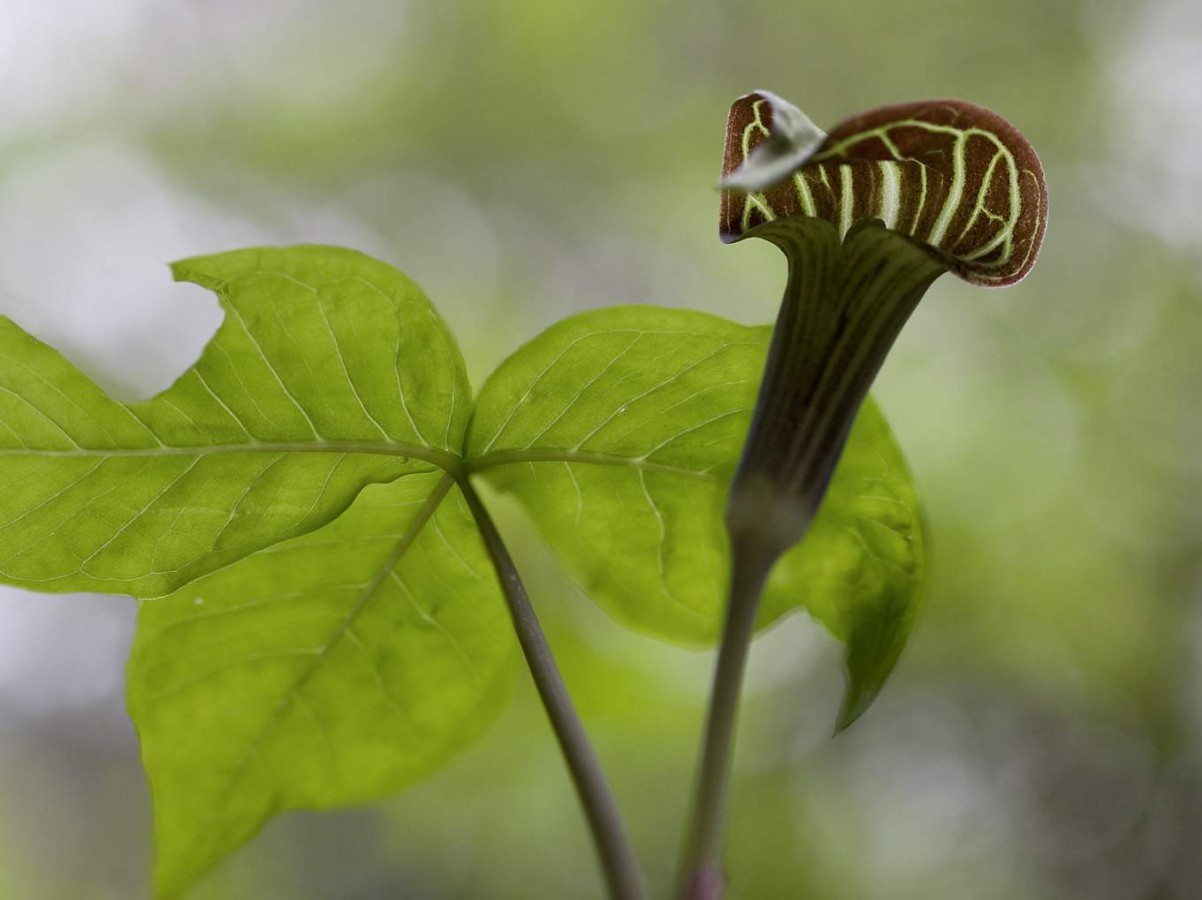As spring finally arrives in the Finger Lakes, the first Jacks-in-the-Pulpit (Arisaema triphyllum) begin to emerge from the forest floor. The foliage of this plant is minimalistic, consisting of only one or two trifoliate leaves that might easily be confused with sprigs of poison ivy.
It is the floral structure that is truly rich and strange: a fleshy, cylindrical spike, known as a spadix, is surrounded by the graceful curl of a single large bract known as a spathe, which is often decorated with natty white, brown, or purple pinstripes. The flowers are invisible, hidden deep in the base of the inflorescence.
As its name suggests, the plant bears a remarkable and improbable resemblance to a tiny man standing in a tiny old-fashioned canopied pulpit, looking something like a cross between a skunk cabbage (to which it is closely related) and a pitcher plant (to which it isn’t). Nevertheless, its lifecycle recalls Greek mythology more than it does Church history: it’s a dead ringer for Tiresias, the blind, long-lived prophet of Thebes, who spent time as both a woman and a man.
The Jack-in-the-Pulpit grows very, very slowly in the damp gloom of the forest floor. For the first few years of its life, it produces a single leaf that captures whatever dim light manages to filter through the leaves of the trees, squirreling away every extra bit of energy in its underground corm. The plant would be vulnerable to herbivores if every part of it were not saturated with large crystals of highly poisonous calcium oxalate. Most animals wisely leave it alone, though black bears dig up and eat the corms with relish, apparently taking advantage of their laxative effects.
After two or three good years, a plant may put out an inflorescence containing only male flowers: the plant’s existence is still marginal, and it takes much less energy to make pollen than to make fruit. If conditions remain favorable for several more years and the corm has grown large enough, it may cautiously begin to produce both male and female flowers in its “pulpit”; eventually, if all goes well, it may be so bold as to put out two leaves and mostly, or only, female flowers. Whenever conditions deteriorate, it will revert back to producing male flowers and only a single leaf. It switches sex in this way, year after year, for several decades and reportedly up to a hundred years.
Although some of its physiological adaptations are remarkably sophisticated, its pollination strategy is fairly crude. It cannot self-fertilize because the male flowers die before the female flowers are mature, so it needs the help of insect pollinators. The spathe emits a mushroom-like scent in order to attract tiny gnats that lay their eggs on fungus. Once the insects crawl inside, they become disoriented: the hood of the spathe blocks light shining from above, the bottom of the pulpit is often pale and translucent, and the dark and light stripes make it impossible for them to tell which way is up. Floral structures with male flowers have small escape hatches at the bottoms of their spathes, but those with female flowers are dead ends. Gnats foolish enough to fall into a female plant after falling into a male one may accidentally pollinate a few flowers before they die inside. In late summer, the spathe withers to reveal a cluster of bright red fruits that are just as poisonous as the rest of the plant.
By turns both beautiful and deadly, male and female, the Jack-in-the-Pulpit is a jack-of-all-trades. It has been used as both a food and a poison, a medicine and a contraceptive. Native Americans used the berries to make a red dye, and European settlers used starch from the corm to stiffen their clothes. Like Tiresias himself, the plant is believed to have the power of prophesy: a seed swirled in a cup of water will reveal whether a sick person will live or die. Perhaps Jack-in-the-Pulpit is the Tiresias of our damp forest floor.


